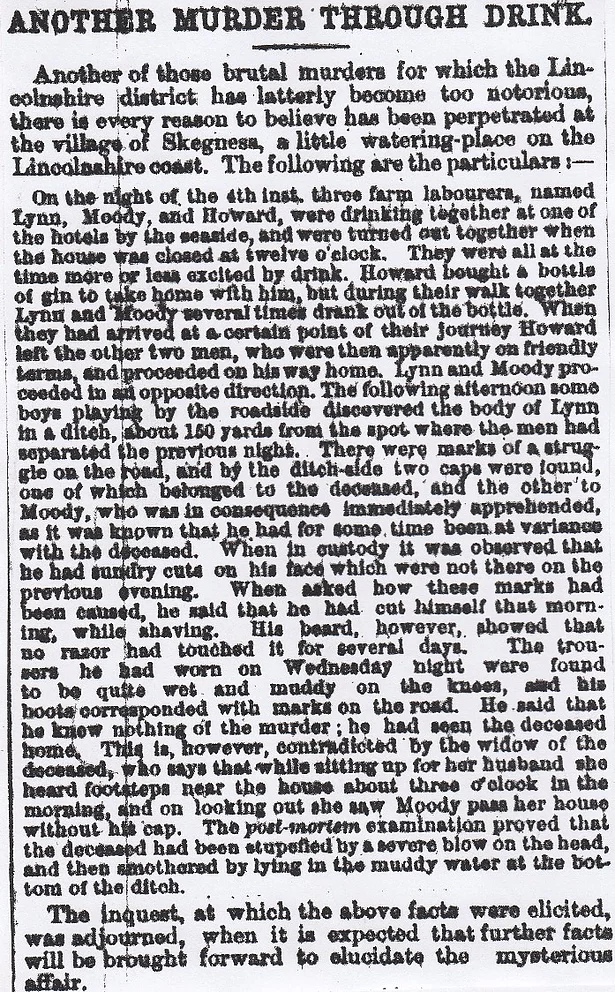LINDSEY TOWNS CONSIST OF: Alford, Barton-Upon-Humber, Brigg, Caistor, Gainsborough, Horncastle, Mablethorpe, Market Rasen, Scunthorpe and Spilsby.
1/ Barton-upon-Humber, (Fatal Accident) October 1860

2/ Barton-on-Humber, (Barrow) October 1889 (Body Washed Ashore)
The naked body of a young man was discovered washed up on the bank of the River Humber at Barrow Haven. It is thought to be the body of a London news reporter, who was in Hull, reporting on the Congregational Union. His clothes had been left on the bank, nearby, and they have the name “A.J.Brown” inserted on the tags on the inside.
3/ Barton-on-Humber, March 1906 (Wife and Two Sons Dead)
Railway clerk, William Marshall, living at Westfield Road, went home for a spot of lunch and found the place locked up. He smashed a window and entered the building, only to see his wife hanging from a hook in the kitchen. He cut her down and checked her pulse but she had already expired. On searching the rest of the house he found eight-year-old Herbert and four year old, Donald, laid on the bed with their throats slit from ear to ear. The last person to see Mrs Marshall alive was the milkman at 8-30, who observed that seemed in good health. One thing that was slightly amiss was that the curtains downstairs were pulled together, as though she didn’t want anybody seeing into the room.
4/ Barton-on-Humber, (Intended Murder) January 1867 (Photocopier broke)
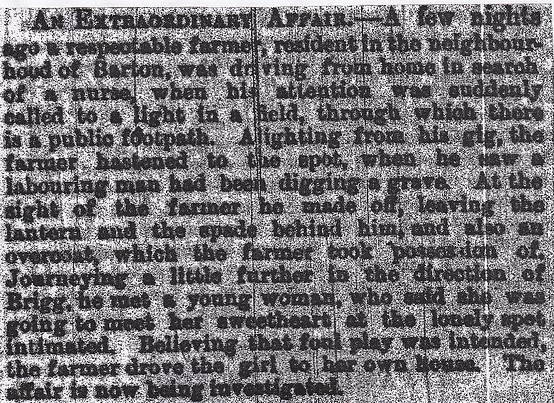
Alford-Lincolnshire
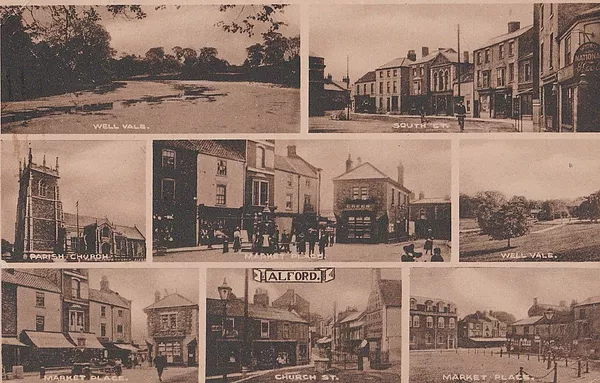
5/ Alford Poisoning, 1824 March
This actually occurred in In Saleby or Ailby, just outside of Alford. John Smith was executed at Lincoln Castle for the wilful murder of Sarah Arrowsmith by poisoning her with arsenic. Smith and Arrowsmith had become parents about three years previous. Now Arrowsmith was going to break the good news to the father-to-be, and everything would be hunky-dory. Smith then poisoned some flour she was going to make cakes with and gave it to her. That’s one version of the story….the other is that he baked a cake for her, laced with arsenic, which she ate and shortly afterwards keeled over in agony and died. Whichever way you look at it, Smith poisoned her with arsenic in a bid for her to either miscarry or to kill her Sarah outright. Smith aged twenty-four, was hanged before a raging mob at Cobb Hall, Lincoln, for the murder of his twenty-five-year-old bride-to-be.
6/ White Hart Inn Suicide, Alford, May 1863
A hawker, by the name of Levi Rouse, alias Strauss, who was around sixty-years of age hanged himself with a bed-sheet in his bedroom at the White Hart Inn (still there in 2016!), and slit his wrists with a pocket-knife. He arrived at Alford on the 28th April 1863 and rented a room at The White Hart. With Levi being well-known in the towns of Lincolnshire, he was described as being of “repulsive appearance and was mostly in liquor”. Levi hadn’t been splashing the cash either, having hardly anything to drink and only a couple of meals, in days. He came downstairs, asked for a gill of ale (quarter pint), then went back up and hung himself.
7/ Welton near Alford, (Train Fatalities) June 1893
Two blokes named Johnson and Kime, living at Welton near Alford were killed on the East Coast line, between Willoughby and Alford. Johnson was decapitated, with the head, nearly a hundred yards from the body and Kime was severely mutilated. They had wandered onto the line and not seen the oncoming train.
8/ Glebe Pit Drowning, Scunthorpe, December 1888
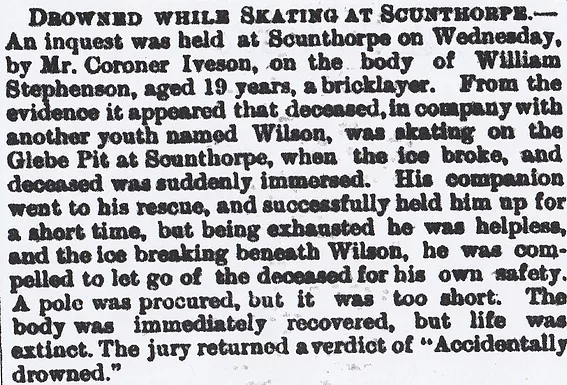
9/ Brigg Manslaughter, June 1888
George Baker of Barnetby, an engine cleaner, and Robert Vessey a platelayer from the same village, were charged with manslaughter. Evidence was given alleging that the accused had a scuffle with George Henry Gilliatt, a tailor from Brigg on May 18th and that Baker hit Gilliatt, two blows on the chest and knocked him down, his head striking against a wall and that Vessey also ill-used Gilliatt. The latter after lingering in an unconscious state, died on May 31st of compression of the brain, caused by fracture of the skull. (What sentence did they receive?).
10/ River Ancholme Drowning, July 1882
On Thursday week, a youth aged sixteen-years named Walter Smith, son of a gipsy horse dealer was drowned in the River Ancholme near Brigg. The youth, who was travelling with a van, was bathing near Hibaldstow Bridge and getting into deep water. He was drowned before any assistance could be rendered. The body was discovered afterwards.
11/ River Ancholme Double Murder/Suicide, April 1893
The bodies of a woman, estimated to be in her mid-twenties and two infant’s, aged two years and five months respectively, were found in the Ancholme at Brigg. The woman was later identified as the wife of George Frith the clerk at Brigg Railway Station. She left home in the morning and was seen about an hour later near the river bank and then seems to have completely disappeared. Now we know why, but the reason for her killing her two children and herself is not yet unknown.
12/ River Ancholme Drowning, June 1859
A boy named William Draper aged about twelve years, and the son of Mr Draper of Old Chapel Yard, climbed aboard a vessel docked in the Ancholme to fish when he fell overboard and was drowned. The parties who took the body out of the water conveyed it home instead of taking it to the nearest house or building and trying to restore animation. The poor little fellow had not been long in the water. A verdict of “Accidentally Drowned”.
13/ Castlethorpe Bridge Suicide, near Brigg, December 1884

14/ Caistor, (Violent Robbery) July 1822
Joseph Burkitt and George Barton were a two-man crime wave in Caistor, and one day with the help of William Goodwin, they beat and robbed John Twigg of his cash and valuables as he was making way from Hull to Market Rasen. Burkitt coshed him over the head, then nicked his money and even his coat was taken off his back. Let’s put it nicely if brains were petrol Burkitt wouldn’t have enough to get out the garage, as he rather brazenly walked about Caistor in the man’s jacket. Twigg saw him and he was arrested.
Goodwin and Barton got away with transportation for life to Australia, and Burkitt got the death penalty.
15/ Caistor, April 1859 (Confesses to Murder-43 years ago)
While on his death-bed in Caistor, a man named Sisney confessed to being an accessory to the murder of a young shepherd by the name of Thomas French in November of 1816. Two other accomplices, he named, who were long since dead but they assisted him with the crime. Those two were arrested on suspicion of the heinous act, but not enough evidence was gathered that would incriminate them.
16/ Caistor Market Place Fatality, July 1841 (Picture from the 1950’s)
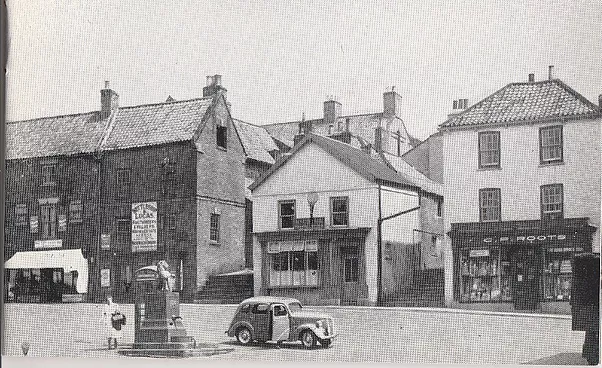
In late June, Lord Worsley arrived with a party in tow, to Caistor. He stood up in the Market Place, which probably hasn’t changed all that much, then addressed the electorate. He did his speech and then Philip Skipworth from Laceby was next up. He talked for a couple of minutes, then suddenly went faint and dizzy and keeled over dead.
17/ Horse Market, Caistor Murder, October 28th, 1919
Pregnant domestic servant, Annie Coulbeck aged thirty-four, was strangled at Pigeon Spring, Horse Market, Caistor, and found dead in the kitchen of the house where she worked. William Wright an ex-army man was arrested soon after her corpse was discovered. In March of 1920, he was executed at Lincoln Prison by Thomas Pierrepoint and he confessed to murdering her but showed no sign of remorse for his horrific deed. The reason for his outburst and fit of temper that led him to throttle the poor lass, was the green-eyed monster, jealousy. Annie had a brooch on and he was adamant that another man had bought it for her. There was a history of mental instability in his family, so this really came as no shock. (Is she buried at Caistor?)
18/ Beckey Lane, Gainsborough, September 1861 (Fatal Accident)
A painter named George Calvert who worked from Spring Gardens had a terrible accident while at work. He was painting a window in Beckey Lane when he fell off the ladder and landed head-first on the pavement. He was lifted up and blood flowed out of his nose and mouth, as well as from a dreadful gash in his skull. He never opened his eyes or spoke and in about five minutes after he’d been taken to Mr Kirkby’s house, he had expired. It is believed that the deceased suffered a fit at the time of the accident.
19/ Sandsfield Lane Crossing Suicide, Gainsborough, April 1870
On Tuesday last at noon, Thomas Harpham, the oldest innkeeper in Gainsborough, placed himself before an express train on the M.S.L.Railway line at Sandsfield Lane Crossing and was instantly cut to pieces, with the body being decapitated and the legs cut off.
20/ River Trent, (Boy Drowned) Gainsborough, July 1882
George William Clapham aged thirteen-years, residing in Back Street, Gainsborough, was bathing in the River Trent near the Great Northern Railway Wharf with three other lads. He was seized with cramp as he suddenly sank and was carried away by the rapidity of the stream, which at this point is both wide and deep. All efforts at a rescue proved unavailing. The police are occupied in dragging the river for the body, but some time will probably elapse before it is recovered.
21/ Gainsborough Mystery, May 1888
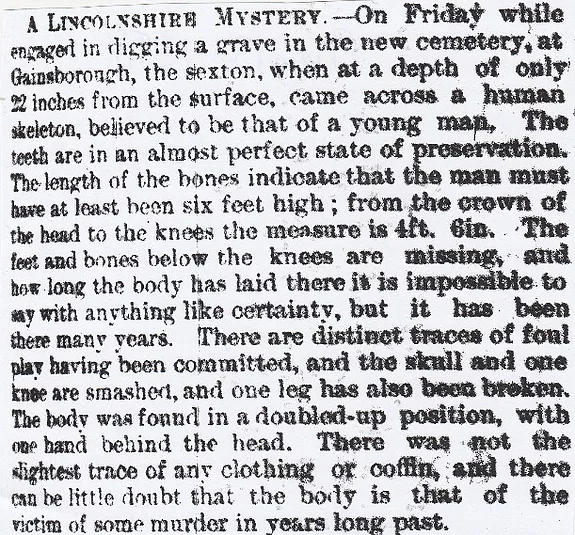
22/ Gainsborough Railway Station Death, January 1888
A fatal railway accident occurred at the M.S.L. Railway Station at Gainsborough. A coal merchant named John Stead, just over sixty years of age, was at the station superintending the shunting of some coal trucks with an engine of the company. Stead, who was a little hard of hearing, stepped onto the four-foot when the train from Hull, due at Gainsborough at 12-33, came up and struck the old fella on the head, knocking him down and cutting his left leg off. Death followed soon afterwards.
23/ River Trent Drownings, July 1887
67-year-old Charles Rhodes, a steward on board the steamer “Isle of Axholme”, was found in the river on Saturday afternoon after going missing the previous morning, with no marks of violence. His cash was balanced, all affairs were in order and it is supposed he fell overboard. Whilst police were removing the body, information came of the death of William Box by drowning. Deceased was seen alive in the river but sank before assistance could reach him. His body was recovered quickly but efforts at resuscitation failed. Both cases were “Found Drowned ” verdicts.
24/ Bridge Street, Gainsborough, August 1879 (Ill-Treated, Starving Woman)
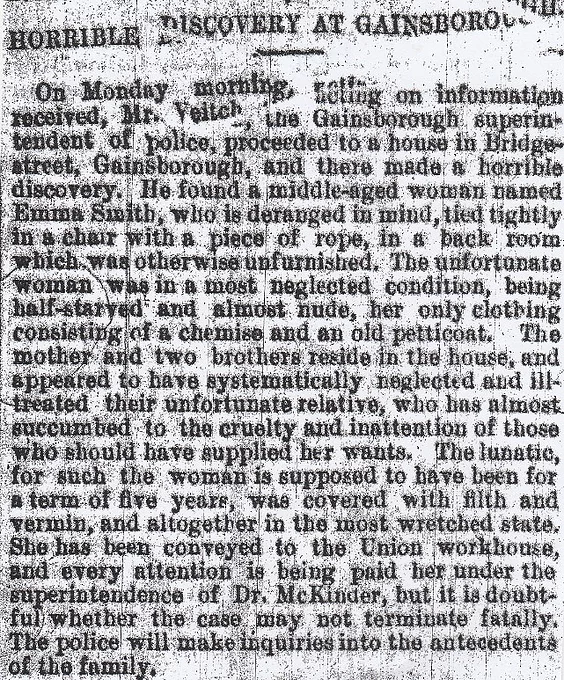
25/ Dear Street, Market Rasen, August 1858 (Sister’s Premonition)
54-year old Robert Mitchell, an ostler, died while sitting in his mother’s house in Dear Street, Market Rasen. A weird part of the story was that his sister, who works for a family in another village some miles from Market Rasen, had a dream that her brother was sat at home and died. It was so lucid that she was determined to go and warn him the very next day. Just as she opened the door to her mother’s house, she found her brother’s body sat there.
26/ Gallamore Lane Suicide, Market Rasen, June 1888
Edward Ellis aged seventy-eight-years, who resided with his son in a cottage near Gallamore Lane, put an end to himself by blowing his brains out with a double-barrelled gun loaded with shot. The deceased had been suffering from depression for quite a while, came downstairs in the absence of his son and his wife, took the gun off some hooks in the room, placed the muzzle to his right temple and fired. He was found by his daughter-in-law.
27/ Walesby Road Fatality, Market Rasen, March 1886
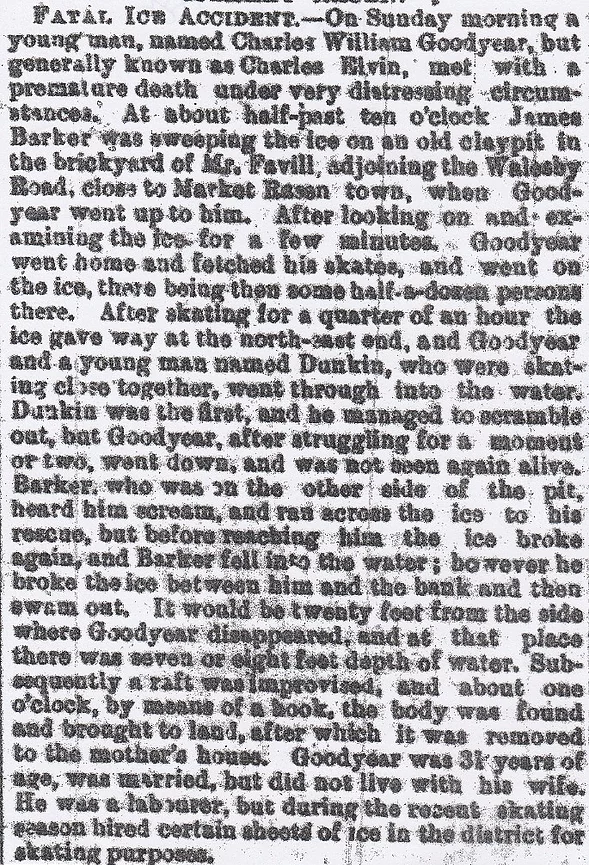
28/ Market Rasen Child Murder, November 1864
This is a strange story about Eliza Wilson, a domestic servant who worked for Mr Proctor at Market Rasen. She was alleged to have concealed the birth of an illegitimate child. Mr and Mrs Proctor went out one night and when they got back they asked the whereabouts of Eliza and they were told that she had gone home as she was feeling poorly. When Eliza got to her house in Serpentine Street, she told her mother that she was pregnant and expecting very soon. A doctor was summoned but when he got there they told him that the child had been stillborn. He asked to see the infant and was given the carcass of a cat, skinned, teeth smashed out and its tail etc sliced off. The doctor called on police suggesting that she had given birth not long ago, but where was the little mite?Eliza was put in a police cell for the night and searching has gone on at her home and the home of her employer. Portions of the cat were discovered at Mr Proctor’s, but the child remains missing.(Was it ever found?)
29/ Market Rasen Suicide, February 1883
George Richardson aged twenty-two, son of Oxford Street baker, James Richardson, killed himself by taking a packet of Battle’s Vermin Killer. He had been seeing a young lass, a barmaid at the Gordon Arms and he’d just received a letter from her telling him to forget all about her. He wrote asking her what was happening and she replied with the exact same answer….forget about me. He went to Mr Payne’s chemist and got the vermin killer, then went out that afternoon to take care of the horses at the stable in Chapman Street. It was while he was here that he diluted the poison and swallowed it. Then he walked back home and got a cup of tea while chatting with his sister, Mary Jane. She spotted that he looked pale and ill and he told her to contact their father, who was in Hull at the time. Instead, she got the doctor and he uttered these words, which were:-“Give me a kiss Jennie. God forgive me!”.
Mary Ann asked him “Is it through that girl, George?”, and he replied “Yes; it’s that girl that killed me”, although even at this point she still had no idea that he’d taken anything. Later evidence suggests that he and Jane Shelton, the barmaid had a quarrel and had not parted on very good terms. The verdict was “Died of self-administered strychnine poisoning, while in a state of temporary insanity”.
30/ Clark’s Mill, River Rase, Market Rasen, April 1880 (Teenager Drowned)
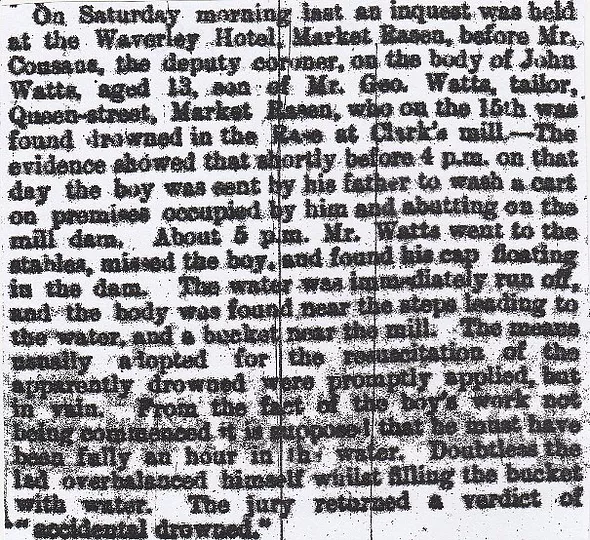
31/ George Hotel Suicide, Spilsby (Still there!) November 1892
Charles Cook, the son of the George Hotel’s landlord, jumped from his bedroom window at the hotel while in a frenzy and was discovered later in the day, hanging in a stable. The George Hotel is next to the church. (Looked in 1896 Kelly’s Directory and found an Edward George Cook in charge of a commercial hotel, so he must have continued after his son’s suicide.)
32/ Spilsby Fatal Struggle, September 1905
Police-Constable Woolley of the Lincolnshire Constabulary was about to arrest a tramp who was drunk as a skunk, in the police station and lock him in the cells for a night to sober up. An altercation took place between the two and during the scuffle Woolley fell on top of the tramp causing his death. Post-mortem results revealed that death was brought on by a heart attack which was accelerated by the excitement of the scuffle.
33/ Spilsby Suicide, August 1866
Thomas Trafford, a shoemaker, aged fifty-six-years, killed himself by hanging. A neighbour of his, Mary Stainton, said that she saw the chap at seven a.m., just coming into his place and entering and then leaving the door ajar. On looking out the window later on she spotted him stood inside, with the door slightly open. Realising there was something wrong she popped round, but she found him hanging with one foot on the toilet seat and the other a few inches above the ground. Help was acquired and he was cut down by his two son’s. Later on, she stated that it was only about ten minutes from when she saw him last to popping round, that he must have decided to exterminate his life. Trafford had been on the bottle for the last three weeks or so.
34/ Spilsby Union Workhouse, (Girl in Flames) May 1877
A terrible accident occurred at the Spilsby Union Workhouse, when a ten-year-old girl named Clark, was standing near the fire when her dress caught fire. The only persons nearby were not adults but two girls aged about the same as Clark and they ran to get help. Clark ran into the fresh air, with the master, on his dinner-break at the time, grabbing a coat, then ran towards the human torch. He threw the coat over her and bundled her to the ground and then sent for medical assistance also. The burns were dressed but she was that far gone that she eventually died the next day.
35/ Queen’s Head, Spilsby, (Fatal Affray) June 1864 (Queen’s Head was on Boston Road)
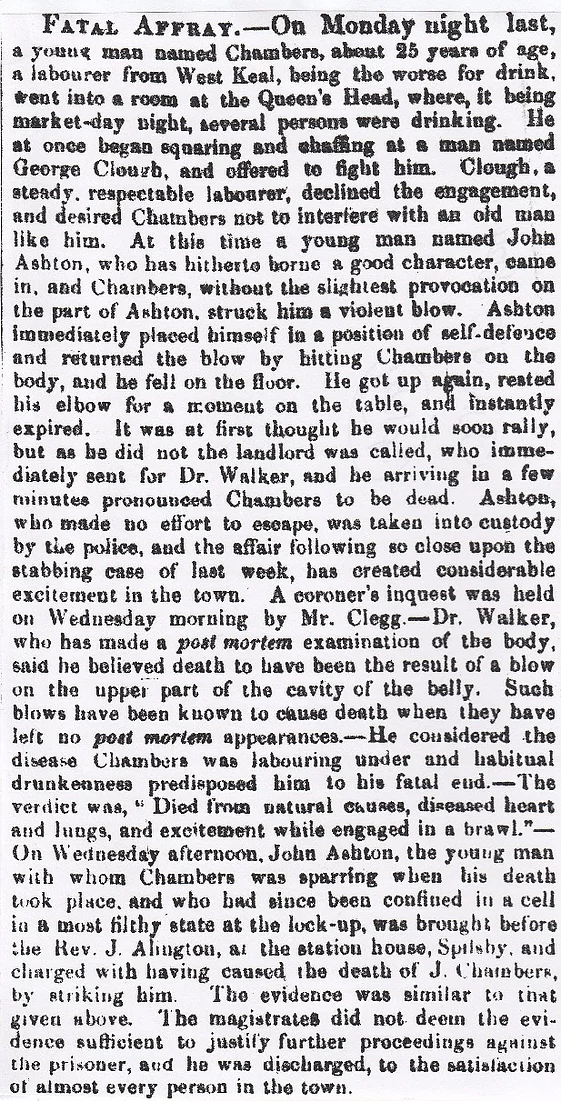
36/ Old Prison Fatality, Spilsby, May 1880
Jess Leary aged thirty-eight, was working at the old prison buildings at Spilsby when he met with a fatal accident. Charles Simons said that himself, Leary and Charles Wood were removing some heavy stone slabs, which made up the ceiling of an old cell, at about three p.m. They were about seven feet long, four feet wide and six inches thick. They were all trying to prise open with crow-bars the outer slab while standing on the centre one. The centre slab suddenly gave way, when Simons moved off it to get another crow-bar. Leary and Wood fell eight feet down but the slab had landed on Leary. They were both extricated at once, with Leary being unconscious and then having died from his injuries. The verdict was “Deceased met his death by the accidental breaking of the slab”. He left no wife or children. (Where were the Old Prison Buildings?)
37/ Spilsby May 11th- June 1st, 1878 (Fatal Accident)
Hannah Blades was a well-known resident of Spilsby who met with a singular accident, just outside the little market town. Two waggons, one belonging to R.Dunley of Eastville and the other the property of Robert Cole of Thorpe Bank, left the Bull Inn and made their way home. Just outside Spilsby, the horse of Cole suddenly became unmanageable and galloped off and ran straight into Dunkley’s horse and cart, which was leading in front, but which veered to avoid an accident. The shafts of both had shattered and Dunkley’s horse took off, with snapped shaft and steps and got outside the wheelwright’s of Mr Watson, when Mrs Blades was approaching. In a singular accident, her dress got snagged in the splintered shaft of the moving vehicle and she was whisked off with the horse and broken cart. When it was finally stopped, the elderly and frail old lady had sustained severe cut’s and bruises, the results of which had caused her death.
38/ Spilsby Doctor Suicide, March 1899
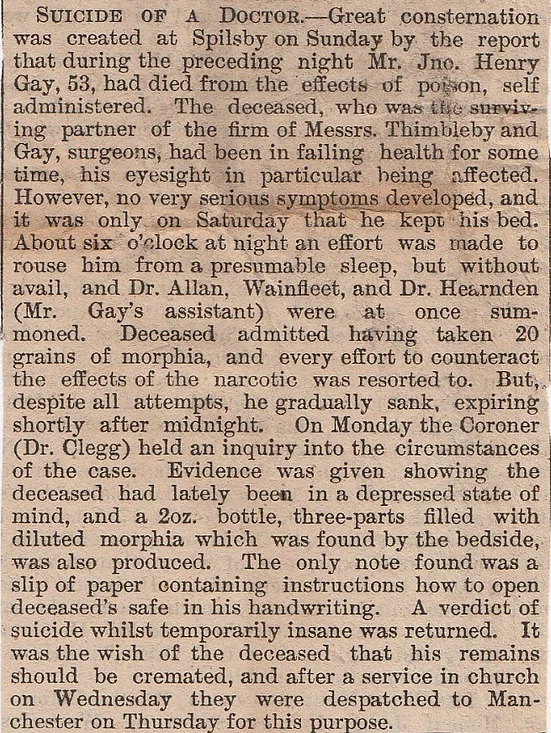
39/ Dawes Lane, Scunthorpe, (Roadside Tragedy) August 1920

40/ Horncastle Gamekeeper Murder, February 1850
Richard Hacker, a gamekeeper, was brutally murdered in Well Side Wood near Horncastle. The Home Secretary has offered a £100 reward for information leading to the arrest and conviction of the perpetrator.
41/ Horncastle, (Arsenic Suicide) July 1868
Inquests normally took place in places near to, or actually the scenes of the crimes. The inquest here at Horncastle took place in the Great Northern Hotel on July 16th, on the body of Sarah Pollexfen of Thornton, who was aged sixty-one-years. After hearing the evidence the jury were of the opinion that death was caused by the poor woman taking white arsenic, she had been at the time of unsound mind. (Was it in the Great Northern Hotel or elsewhere?)
42/ Horncastle Vicar Suicide, May 1853
The Reverend J.T. Clark, the vicar of Horncastle, was suffering from depression and was ordered by his medical practitioner to take a break and enjoy some fresh air and have a change of scenery. He followed the instructions down to the letter and came back after several weeks away. The same afternoon he got back, he put a gun in his mouth and blew his brains out. Reverend Clark has only been here for five years or so and leaves a wife and a large family behind.
43/ Congregational Chapel Fatality, Horncastle, May 1887
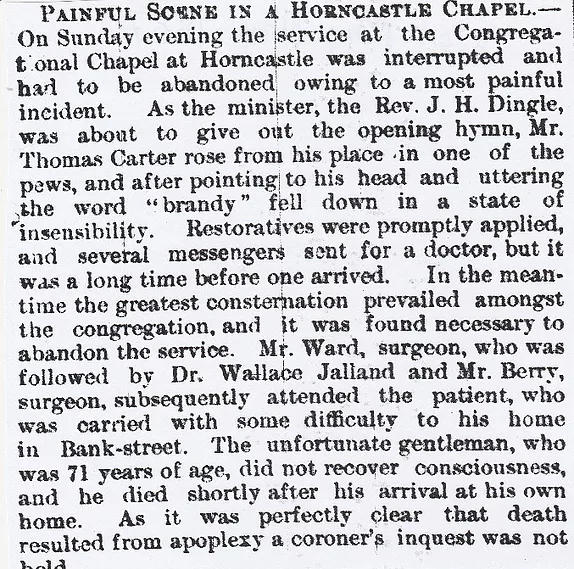
44/ Horncastle Railway Station Suicide, May 1881
As the train left Horncastle for the North at 12-40, it had just got started when the driver observed a man lying down on the train tracks in front of the engine. He put the brakes on, but could not stop the train from going over the man’s body. They rushed back to see if he was still alive but they were confronted with the mutilated corpse which was dressed rather smartly. They took the remains back to Horncastle. There they identified it as that of Frederick Kennersley, who had been in the employ of the Reverend W.W.Taulford at Winceby Rectory and who had just moved to Essex. He took up a position with Mr Coates of Langton, but had only been there a week when he handed his notice in and returned back to Horncastle. No job offers had been forthcoming and he was getting despondent, so in a moment of homeless perplexity, he committed the rash act.
45/ River Bain suicide, Horncastle, February 1887
The dead corpse of Edward Sanderson, a boot and shoe-maker of East Street in Horncastle was fished out of the River Bain by a passing baker. His nose and mouth were bruised and blood was oozing from his mouth. His watch had stopped at 12-55. The water in which he was discovered was only a foot deep and evidence appears to suggest that deceased was suffering from illusions that everyone was trying to ruin him. The verdict was suicide while in a state of temporary insanity.
46/ Queen’s Head Inn (Human Skeleton), Horncastle, September 12th, 1863 (Who was it?)
Workmen were pulling down the old buildings at the Queen’s Head Inn in the Market Place at Horncastle, when they came across a skeleton under the flooring of the back kitchen, about a foot and a half from the surface. It was face down, with the legs crossed below the knees and was buried in lime. How it came to be there or how long it has been buried there, is a matter of guesswork and conjecture at the moment. A medical man did an examination of it and said that it was that of a powerful male six-footer and had lain there for half a century or more.
September 19th, 1863
In regards to the story of the male six-foot skeleton being found underneath the floor at the Queen’s Head Inn in Horncastle, could it be this fellow who vanished in mysterious circumstances around that time?
About fifty years ago, Mr Desborough, a farmer from Sotby, who was about six feet in height, was seen for the last time at the Three Maids Heads Inn at Horncastle. He had gone there to pay his rent but failed to do so, in consequence of his landlord not turning up. Although a diligent search was made for him, he was never seen or heard from again. Many were the rumours then afloat.
47/ Langton Hill, Horncastle, (Fatal Trap Accident) October 1897
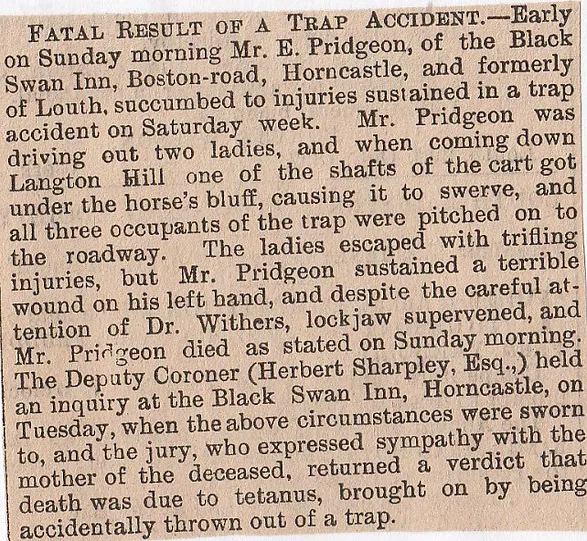
48/ Mablethorpe Drownings, August 1871
A bathing accident occurred at Mablethorpe which resulted in a fatality. Mrs and Miss Woodruffe, wife and daughter of Mr Showler Woodruffe of Horncastle, were both bathing in the North Sea waters when they were carried out into deep water and not being good swimmers, were both drowned.
49/ Mablethorpe Drowning, October 1884
Dr Arthur Kay of Louth in Lincolnshire was drowned at Mablethorpe on October the 23rd while bathing, in full view of his wife.
50/ Mablethorpe, (Body Washed Up) October 1906
A body was washed up on the beach at Mablethorpe. He was later identified as Thomas Martin Perry, a sixty-three-year-old clerk, living at Exchange Road in Nottingham.
51/ Ivy Cottage/Cross Inn Death, Mablethorpe, May 1877
A labourer named Tinker was drowned in a dyke in Mablethorpe. He had been to the Cross Inn for a few jars and it supposed that he fell into the dyke near Ivy Cottage, where he was found by his son-in-law on Wednesday morning. He was drunk at the time of leaving the pub and had lately been addicted to drinking. (Cross Inn- Alford Road and Mile Lane)
52/ Mablethorpe Drowning, August 1877

53/ Mablethorpe Bathing Fatality, July 1876
Mr Seaton aged fifty-six, from a few miles away at Yarburgh near Louth, went for a dip in the North Sea at Mablethorpe beach. He was an excellent swimmer and he circled a lifeboat while he out there, commenting what a nice day it was. He then went back to shore and as he was a couple of yards from the beach, he was seen to stagger then drop to the ground. Several people ran to aid but by the time they got there, his face was black and water flowing from his mouth. He was taken to the Book-in-Hand Hotel where a doctor tried to resuscitate him, but it was too late. They thought he had suffered an apoplectic fit. What made it worse was that his wife and daughter were on the shore, witnesses to all that went on.
54/ Mablethorpe Burning Fatality, January 1890
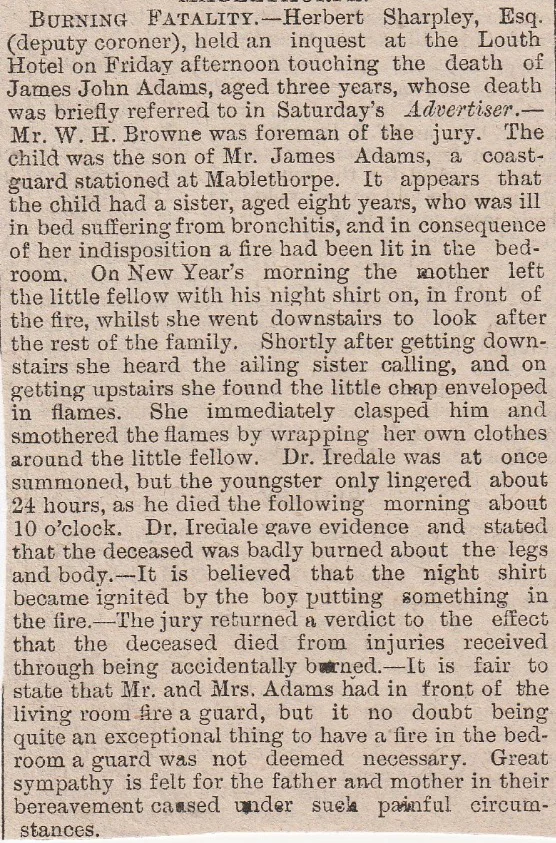
55/ Skegness Boat Accident, August 11th, 1883
The”May” steamboat was lying off the Pier and was taking passengers for a short trip out to sea. Boats were used to take excursionists from the shore to the steamboat, when one of these capsized in deep water, close to the “May”. Whether the boat was overcrowded we don’t know but human cargoes are difficult to manage and always with an element of danger. The occupants were hurled into the sea and people began screaming, shouting for help and wildly flapping about in the water. One man from Leicester had drowned and who it is believed he leaves a wife and two children behind. Three women were taken to the Hildred Hotel in an insensible condition but were restored.
August 18th, 1883
The Coroner’s inquiry into the fatal boat accident at Skegness, returned a verdict “That Walter Seaton was accidentally drowned by the upsetting of the boat”.
56/ Skegness Beach, September 1900 (Servant Girl’s Adventure)
Francis Stanley, a servant girl by profession, was discovered among the sand dunes at Skegness on the point of starvation. Apparently, she had been hiding there for around five weeks, living on brambles and vegetables she managed to glean. Due to her disappearance for such a length of time, a search was made and she was found in the dunes. Stanley worked as a nurse in a family from Leicester that was holidaying at Skegness. She had a quarrel with her mistress about five weeks ago and took the children towards the golf links and beach. While the two elder children were playing on the dunes, she took the infant, got undressed as though ready to bathe and walked into the sea. The other kids noticed and they ran to get the baby, which she had left next to her clothes, then sensibly went back to their lodgings. That was the last time anyone saw her. Police concluded that she had committed suicide by drowning herself in the German Ocean. She was found in an extremely poor condition. (What made her stay there for five weeks!)
57/ Skegness, (Boy Vanishes) August 1877
Another bathing accident occurred at Skegness when a nineteen-year-old youth named Simmons lost his life. The youngster was the son of the manager of the works for Lord Scarborough at this place, went to the shore with two mates for a Sunday bathe. They were messing about in the water, when Simmons, who was bigger than the other two, ventured out a bit further. Before they noticed he was gone, the lad had seemingly disappeared under the waves, with no trace.
58/ Skegness Fatal Drowning, August 1883

59/ Skegness, September 1889 (Lost Child Walks Twenty Miles)
This one is similar to the story of the servant girl who was found living on the dunes at Skegness. This one was of a little girl who was spotted by two ladies from Leicester, who were out for a stroll a couple of miles north of Skegness. They asked the girl where she was from and she answered that she had come from Mablethorpe and her name was Rose. The ladies took her to the police station, where they found out that she was seven years old, her parents were called Walmsley and they lived in Louth. Apparently, she had gone to Mablethorpe with her Mum and two other girls. The mother went off to see a friend and sent the girls to the beach, where they lost each other. Rose has been walking down the Lincolnshire coast to find her sister. Mablethorpe is about twenty miles from Skegness and the fact that she had made it this far, without getting dragged into the sea, is a miracle in its self.
60/ Old Lifeboat House, Skegness, August 1881
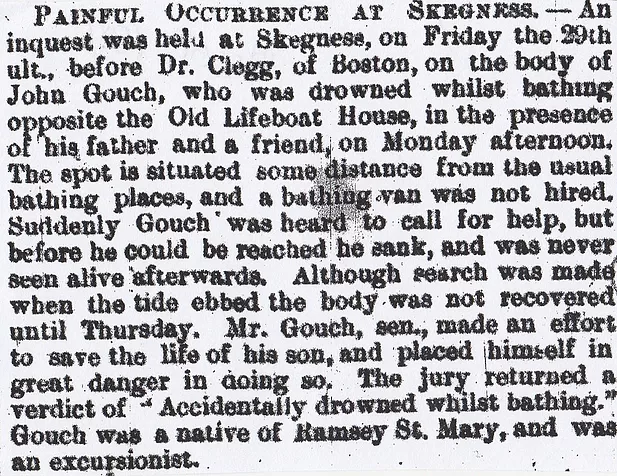
61/ Brigg, (Fatal Accident) December 1897
Charles Briggs aged twenty was working for the lord of the manor, Mr Underwood of Somerby Hall, and he in charge of a waggon load of coke pulled by a couple of horses. He was walking by the side of them, when they suddenly bolted off and in desperation he tried to stop them but fell with the waggon passing straight over his head, killing him instantly.
62/ Brigg Fair Death, August 1869
Mr Swallow of Chapel Farm near Barton was driving his gig from Brigg Fair, when he got to the Wrawby toll-bar the horse was scared by a bloke on a bicycle and it turned around and galloping at full pelt, going against the toll-bar and threw him out. The horse galloped on through the crowds, injuring several on its way, but it hit Mr Christopher Corry from Thorseby near Bourne, the hardest of all. Every effort was made to save his life but he died from the fractured skull and a ruptured blood vessel.
63/ Brigg Railway Station Fatality, December 1877
A shocking accident happened late on Thursday evening to Mr Duckering, the well-known pig breeder of Northorpe near Kirton Lindsey. He was endeavouring to cross the line of the M.S.and L.Railway near Brigg Station when he was run over by the Hull passenger train. When picked up it was found that the unfortunate man had been terribly mutilated, with one arm and one leg being severed clean off.
64/ Brigg Manslaughter, January 1903

65/ Brigg Teenage Suicide, February 1901
Charles Gardham Shephard aged thirteen-years had been found torturing a cat, and when he was told off he answered back. He became angry and being talked to like that and his father had also threatened to “tan his arse”, but never carried it out. Next time anybody saw him was when they fished his body out of the River Ancholme. He had told various people that he was going to drown himself, but they passed off his idle threats. Tragically he carried them out.
66/ Wrawby Road Murder, Brigg, July 22nd, 1824
James Wetherill was fed up with working for a living, so he decided to rob people and nick the money they’d worked so hard for. He waited on Wrawby Road with a loaded pistol in his hand, when along came William Berridge from Brigg. He put his plan into practice and shot the fellow dead, then rifled his pockets and pinched his money and valuables. He was seen digging a hole in his garden, not for the body of Berridge but for the gun he used to kill him with. He was arrested and put in a police cell. While there, the cowardly villain tried to end his own life by slitting his throat, but the surgeon was too quick for him to evade justice that easily and his life was saved and his neck sewn up. While inside prison he confessed to murdering Berridge and was given the death sentence. They had to wait a couple of weeks before they could hang him, to let the self-inflicted knife wound to heal.
67/ Brigg Accidental Shooting, January 1884
Thomas Draper aged ten-years, was accidentally shot and killed in a stable in Manley Gardens in Brigg. Richard Leaning worked for Mr Simpson Green, carter, and he rode with Draper and a lad called William Sanders to Mr Green’s stable in Manley Gardens. While Leaning took care of the horse when they arrived, the other two wafted off and had a look around. Within minutes there was the sound of a gunshot and Sanders came out, looking pale and crying “I’ve shot Tom. Shall I be hung?”. Drapers face had been blown away by the gun, with brain matter protruding. Mr Green said the gun was kept there for shooting rats and vermin. The father of Sanders explained that his son and Draper were looking for a ball, when Sanders found the gun and barely touching the trigger, fired it into the head of Draper. “Accidental death” was the verdict.
68/ Appleby Brickyard near Brigg, (Two Men Drowned) February 1862
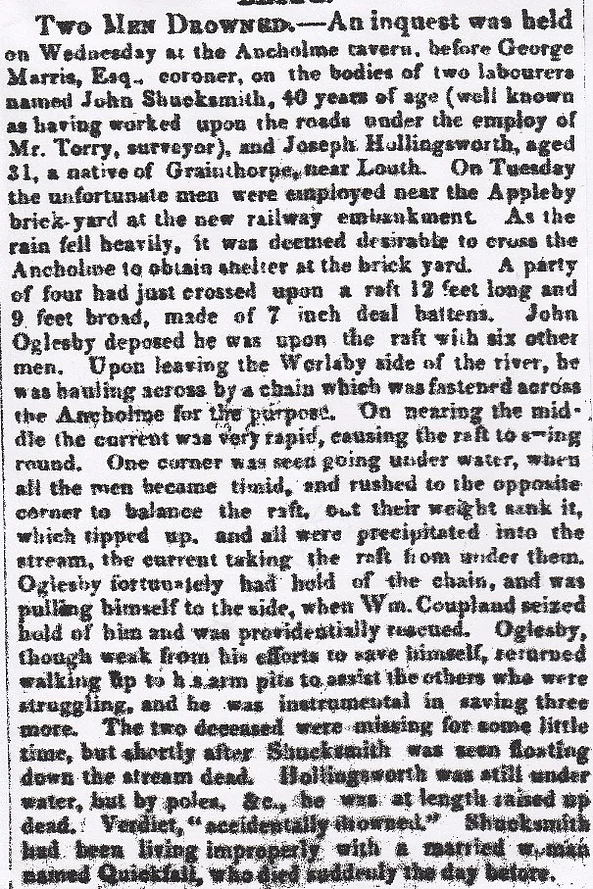
69/ Brigg, (PoliceChief Dies Due to Criminal) January 1865
Mr Eady the Superintendent of Police at Brigg, died of inflammation of the brain, induced, it is claimed by the anxiety at the thought of a notorious criminal slipping through his fingers and who legged it while in police custody. The villain was known as Raggy, who was a habitual criminal with several stints in prison. He was found committing a burglary at Wrawby and was put in the slammer at Kirton. He was handed over to Eady and allowed to go out to the courtyard for a minute, accompanied by a “wet behind the ears” constable, who didn’t keep an eye on him very well at all. He escaped and quickly a search was made when they found out that he’d scaled the prison wall and was now wandering the countryside. Eight policemen were scouring the area and Eady said that they would capture him again with thirty minutes. They didn’t. Eady was called up before the Chief of Police, and over time his health deteriorated, then he died. A month went by, when on the same night Eady met his maker, Raggy was at it again. He again escaped officers and this time jumped into the River Trent to make his getaway. This was one time too many, as Raggy sank, and drowned.
70/ Brigg Wife Murder, March 1861
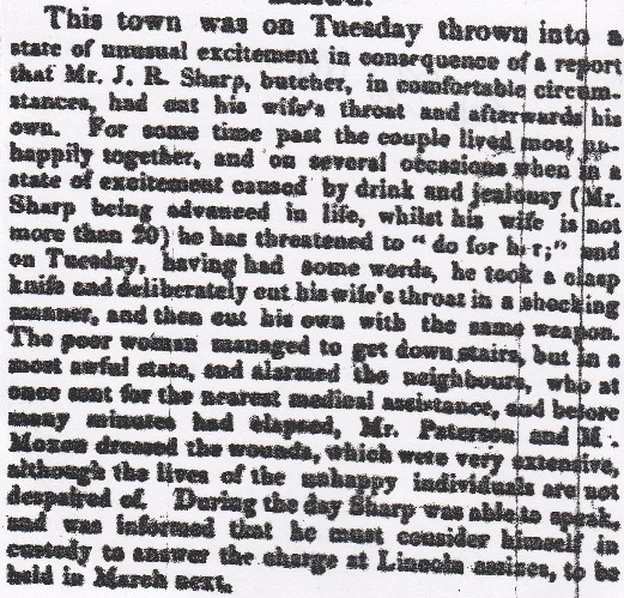
Got him down as John Palmer Sharp aged forty-eight and she was twenty-year-old Sarah Jane Sharp. He had a terrible temper and liked a drink. Also extremely jealous, if any man looked at her, she was accused of having an affair with them. A neighbour heard him say that he’d kill her. The death sentence was spared but he would get a heavy sentence with penal servitude. (Life with hard labour)
71/ Spilsby Suicide, February 1878
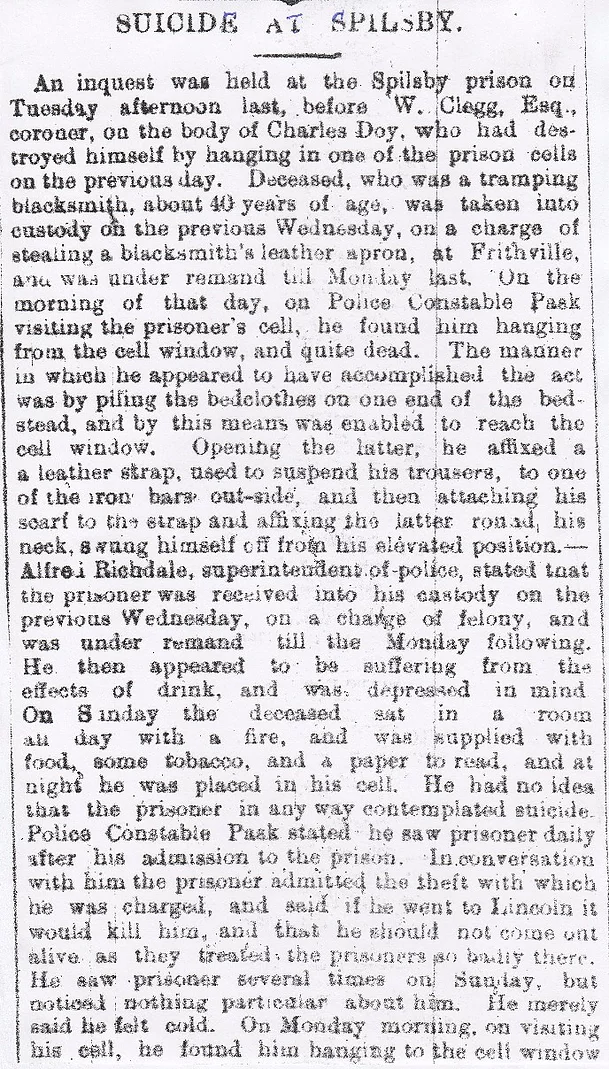
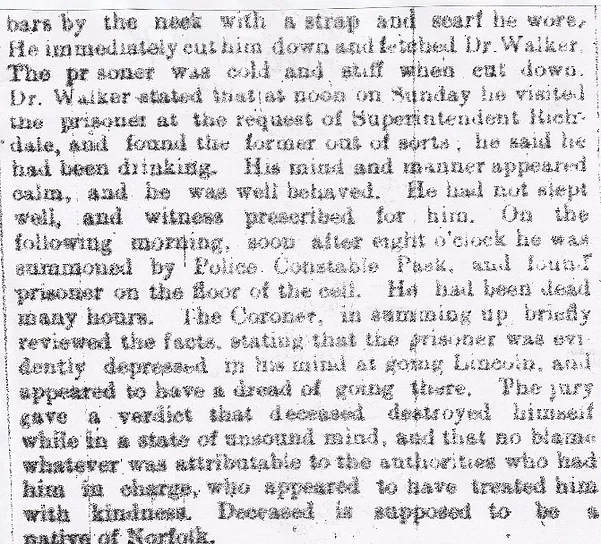
72/ Gainsborough Railway Fatality, December 1891
Henry Simpson, the chief inspector of the permanent way on the Manchester, Sheffield and Lincolnshire Railway, was killed near Gainsborough while trying to climb on board a train while it was moving. He had been employed by the company for forty-two years and was due to retire on a pension very soon.
73/ Sandsfield Lane Suicide, Gainsborough, May 1886
William Whelpton, a joiner aged thirty-three was married with no children. He was living apart from his missus, so he threw himself under a train. A witness spotted him at the Sandsfield Lane crossing when a coal-train from Retford heading for Grimsby approached. He got up and just as it was close enough, he leapt in front of it and let the huge engine and trucks passed over his body. Obviously, the corpse was dreadfully mutilated and nothing was found about his person that would suggest this was premeditated. He had been unemployed for nearly a month since his master’s premises were burned to the ground.
74/ River Trent near Gainsborough, (Husband/Wife Drowned) August 1859
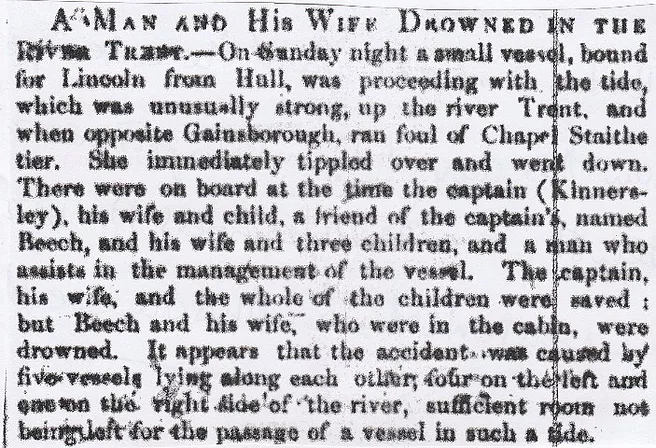
75/ Gainsborough, November 1884 (Starvation of a Child)
Rebecca Fothergill was the mother of an illegitimate daughter named Emily Maud Winn, who was aged only two when she died under the worst of conditions and by starving to death. Fothergill’s husband was in prison and there was little or no money coming into the household kitty, resulting in very little to eat. An order was obtained to send them to the workhouse with the mother saying she’d rather jump in the Trent than go there. The bones of little Emily protruded through the skin and she was awfully emaciated. Emily weighed eleven pounds instead of the normal two stone six pounds. She tried to give it beef tea and milk, but the rest of diet was bread and water. The nurse at the workhouse infirmary said the woman was often unkind to the child and forgot to feed it at all on some days. The verdict was that “Deceased had died from want of proper nourishment and such nourishment was not withheld with malicious intent”. I thought she did!
February 7th, 1885
Rebecca Fothergill, 25, married, who had been convicted the previous day of the manslaughter of Emily Maud Winn, her daughter at Gainsborough on 23rd November, was sentenced to six calendar months imprisonment with hard labour.
76/ Woolpack Hotel, Gainsborough, June 1875 (No.4 Lord Street, demolished in 1969)
Mary Ogden used to work at the Woolpack Hotel in Gainsborough but left the place on the 14th of the month. After a few days the landlord, Mr Green, started hearing strange bumps and noises in the night, but their guard-dog never barked so he just assumed it was him moving about and not burglars. This kept on night after night, but no sign of a break in. One day he found a room in the upper section of the hotel in an unusual state. A search was made and there beneath the bed was Mary Ogden, who never said a word. Police were called and he explained to them that it was an ex-employee of his and he thought there was a concealment of birth. The police had arrived in the nick of time because Mary had tried to kill herself by tying a handkerchief round her neck, in order to strangle herself. After much questioning, she said she would come down every night and go to the larder to get food and drink, and that the dog knew her well so it never barked. Mary Ogden will be charged with concealment of birth and attempted suicide.
77/ Gainsborough Police Station Suicide, May 1865
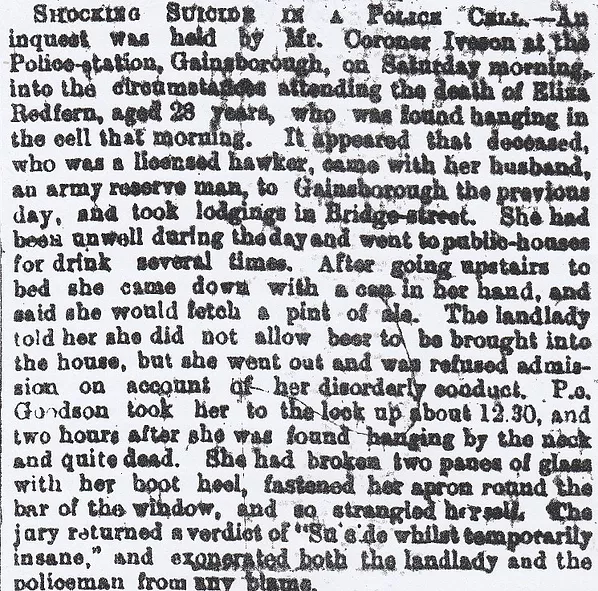
78/ Horncastle, (Petition to Release Murderer) May 1889
A letter was received at Boston from the Home Secretary, stating that the Queen has authorised an early release from gaol of John Garner, a Horncastle man who was sentenced in 1863 to penal servitude for life for the murders of his mother and his wife. 8000 signatures from Lincolnshire inhabitants were gleaned, with each believing that Garner was innocent of the crimes he was accused of.
79/ Horncastle Navigation Canal Suicide, April 1867
The body of a baker named, Thomas Hall, was found drowned in the Horncastle Navigation Canal. A youngster by the name of Lyon was off fishing when he observed the hat and stick that the deceased left behind on the bank. Then he saw the corpse floating on the surface, face downwards. He ran to get a policeman and returned with Superintendent Thoresby, who, along with P.C. Cunnington dragged the body out. It was still warm so he had not been dead that long. The verdict was suicide whilst labouring under a fit of temporary insanity.
80/ Cagthorpe Suicide, Horncastle, May 1862
The body of Josiah Buxton, a newspaper agent was discovered with his throat slit from ear to ear and had been dead for some time. He lived in the house in Cagthorpe and had been there on his own for several months. Neighbours hadn’t seen him in a while and he was usually at the train station to meet his newspaper parcel, as the 8-15 to Lincoln pulled in. They tried knocking on the door and shouting his name but no reply was forthcoming. The police superintendent got a ladder and climbed up to his bedroom window. When he gazed into the room he saw poor Buxton laid out on the bed with his head barely hanging on to his neck, with the razor clutched in his left hand and the bed sheets soaked with blood. For quite a while, Buxton had seemed disturbed by something and his behaviour was that of a man with an unsound mind.
81/ Water Mill Lane, Horncastle, (Man Walks into River) December 1915
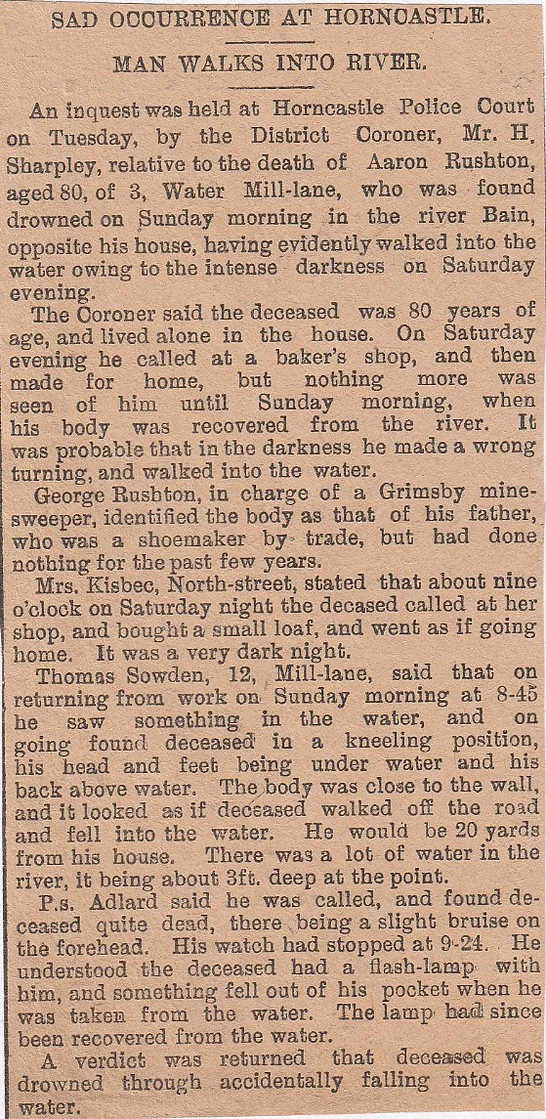
82/ Horncastle, William Marwood- Executioner
In 1879 Marwood hanged the Irish servant, Kate Webster, who murdered her employer, Julia Martha Thomas, and who was hanged at Wandsworth Prison in July of the same year. The skull of Webster turned up in Sir David Attenborough’s garden at Richmond in South West London in 2010. In 1882, William Marwood received a death threat, with a Dublin post-mark on the letter, sent by the “Secret Society of Assassination”, warning him that if he sets foot in Ireland to perform another execution they will kill him. He was told that he was being watched and was followed from his home in Horncastle. It also alludes that he had a narrow escape when he was in Armagh, but got away with it. The Home Secretary and Sir William Harcourt said Marwood would be given the greatest protection wherever he went.
In 1890, his estate was finally settled, as there was a difficulty as to the legal heir. He died insolvent, or not having a penny to his name, and the Bankruptcy receivers were involved. He was paid handsomely for each of his 176 executions, so where the money disappeared to is anyone’s guess. I found a letter by Marwood at auction and it mentioned that if his services were required he could be contacted at the Struggler Inn, Lincoln. Also, he bought property, which wasn’t always as profitable as it looked and he also asked for £50 to hang the Phoenix Park murderers, but only got half that sum.
83/ River Bain, Horncastle, (Tramp Suicide) November 1877
The body of forty-year-old tramp Elizabeth Edmonds was discovered on the 10th of November in the River Bain. Fellow tramps testified to their whereabouts and having seen her in various places around Lincolnshire and as to her state of mind. One of these was William Johnson from Grimsby who saw her three weeks ago in Boston, saying she was very despondent due to not getting any fresh clothes and that it would be easier to do away with herself. William Brown, another vagrant, met her going from Scamblesby to Horncastle, also saying that was going to the Union (workhouse). When in Horncastle she went to the Kings Head Inn where three men bought her a gill (a quarter of a pint) of ale and she was given a penny. She said she was going to seek lodgings, but went to the chemists and a baker’s instead. William Carter, a painter, said that just after eleven p.m. someone came running up to the Stone Bridge yelling that someone was in the water. Alfred Espin was on his way back from the Red Lion Tap and got about halfway over Bow Bridge when he heard a yelp and a splash about fifty yards from where he was stood. They all ran to the spot and got deceased out of about two feet of water. The verdict was one of those that determine whether or not it was a deliberate act or an accidental drowning.
84/ Back of King’s Head Inn, Horncastle, January 1865
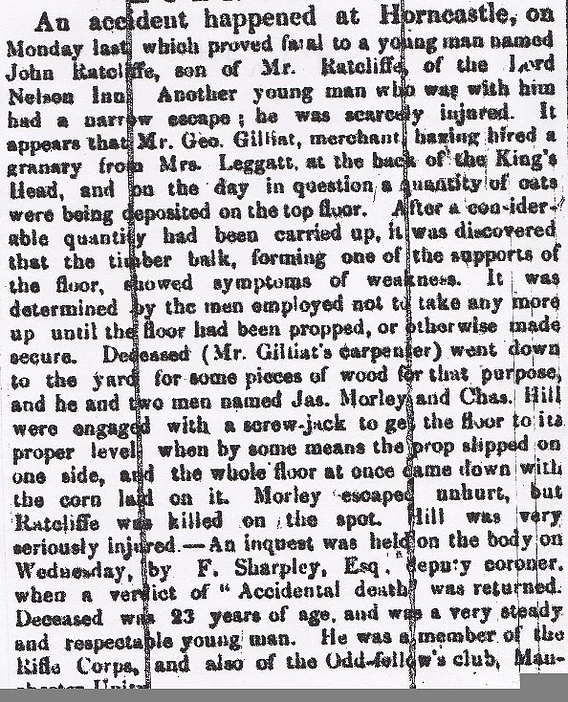
85/ Horncastle Fatal Accident, September 1869
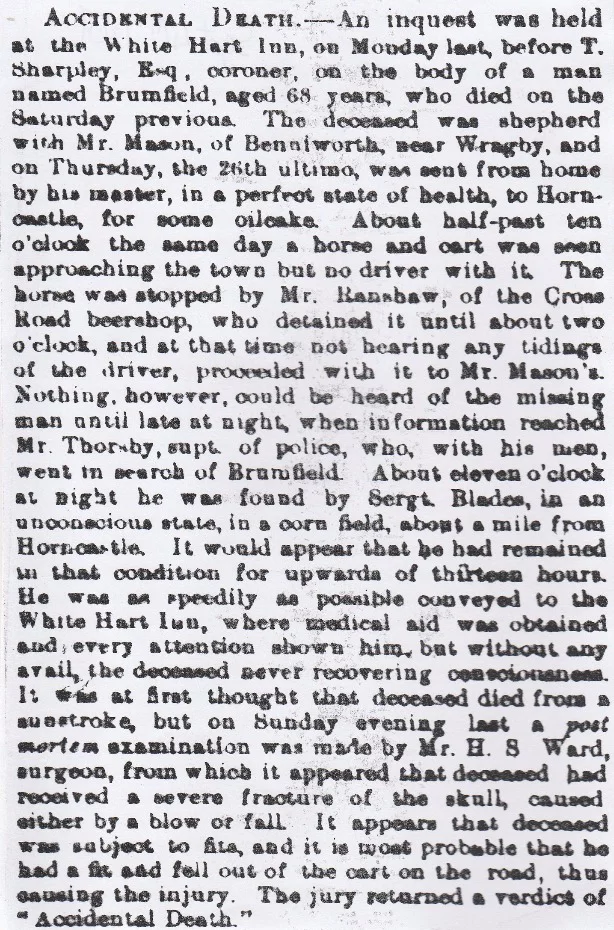
86/ Alford October 1891
Two stories here, about the finding of dead bodies in woods near Alford. Don’t think they were the same victim. First is the corpse of James Herbert, was found swinging by a rope in a tree in a woods near Alford. Herbert had lost a leg recently and was very depressed about his prospects in the job market, with only one leg. He was living at brother’s house, it was there that he left the following letter:-
“I cannot endure the thought of further encumbering you with my presence and sooner than return to the Union, I have determined to end my life.”
87/ Greenfield Wood Corpse, near Alford, Mid-September 1891
A group of ladies who were nut-gathering in the woods, found this decaying corpse strung up in a tree at Greenfield Wood near Alford. The body was totally devoid of flesh and was still clothed. It was identified as that of Henry Taylor, a labourer from Ailby near Alford. Henry had been missing since the end of May, around three and a half months ago. Police and friends had been searching for Henry in this woods before but somehow passed him by. It is thought that he was covered by small nut trees and long grass, so remained hidden. (Is Greenfield Woods off Greenfield Lane, North-West of Alford, past Ailby. Next to Greenfield Farm?)
88/ Alford Railway Station Suicide, August 1904 Governess Kills Herself)
Isabel Mason aged thirty-six was working as a governess to the Reverend H.S.Miles, vicar of Whetstone in Middlesex. The suicide note she left explained her reasons for killing herself, the main one being that there was cruel gossip and slanderous remarks made about her which were vicious and untrue. She asks the Reverend to forgive her and “Pray, pray for my soul” and thought that Mr Miles had mentioned that she was incompetent. Miss Mason threw herself in front of an oncoming train just outside Alford Station and was badly mangled. Insanity was in the genes of both sides of the family, so this was not a surprise.
89/ Willoughby Road, Alford, March 1869 (Dead Infant)

90/ Alford Suicide, August 1869
Ann White of Alford was being taking care of by Askew Wood, a friend of more than twenty years. He last saw her alive at 19-20 with a shawl on her back and he had said he was staying with her, at her request, mainly because nobody else would look after her. They had a cup of tea at 17-00 and then at 19-00, she asked for some tea and toast. He went away to make them and was gone about twenty minutes. He came back in to see her sat there with a huge gash in her throat, holding a bowl and with a pen-knife next to her. He confessed that he thought her mind was deranged and she was an extremely nervy person, being confined to bed since the death of her husband.
91/ Bourne Road Skeleton, Alford, April 1881
On Thursday afternoon a man who was digging for gravel on a piece of land belonging to Mr Hasnip in Bourne Road Alford, struck his spade against a hard substance, which proved to be a human skull. On loosening the earth it became apparent that a human body had at some time or other been indecorously interred. The skeleton held together somewhat firmly, for, as the man said, he had to knock the head sharply to separate it from the neck bones. Judging from the appearance and size of the bones the body was that of a woman.
92/ Alford, Murder or Suicide? July 1906
Ann Powell aged sixty-nine, lived on her own in Alford. She was discovered when smoke was seen coming from her house, and when she found she had been brutally hacked to death with a hatchet, as the room and floor were covered in blood spatter. The murder weapon was found nearby. Family members said she had become delusional and a book on the subject of dying Christian martyrs was found near the body, open on the page which read: “For this cause I was sent that I should suffer this fire for Christ’s sake. This grim fire I fear not. My soul shall sup with my Saviour Christ this night.” Although it looked as though this was a murder scene, Mrs Powell had in fact managed to kneel down, with the idea of copying a dying martyr, then somehow inflicted the awful wounds on herself. (How did the fire start?)
93/ Alford Attempted Murder, December 28th, 1889

January 11th, 1890
The boy Howis was again brought up in custody on Tuesday last, charged with the attempted murder of his step-mother and was again remanded until Tuesday next. This is in consequence of the serious illness of Mrs Howis, who it appears, was stabbed in several places about the head and is very prostrate from loss of blood.
94/ Alford Child Murder, November 1889
Joseph Turner, a shoemaker from Alford, was charged with the wilful murder of his nine-year-old son, Joseph Martin Turner. His brother, John Turner, said that two of them lodged at his house. On the night of the 29th of October, the two brothers argued and Joseph got his son out of bed and walked out of the house. He saw them in a pub the next day and asked them to come home and have something to eat, but little Joseph said he didn’t want anything to eat. This was the last time he saw the boy alive. On October 31st, John Turner got this letter through the post :
“John Turner- When you get this letter, I shall be dead, and the boy I have took with me, so he shan’t be a trouble to none. Our bodies you will find in the brick-pit at the bottom of the field. Please let them all know. I can’t stand it any longer. What with one or another I can’t be here any longer. Bury me aside of Tet (his wife), and let the boy lie atop of me. The watch is for Annie. Goodbye to all. J.Turner.
P.S.I hope and trust you will turn over a new leaf. May the Lord bless me and the boy and forgive for the deed what I have committed. Tell them not to weep for me. I could not rest since Betsy was taken away from me.”
The thing was that Joseph Turner never killed himself as promised in the letter, just murdered his own son. The boy was found in about four feet of water at the Rookery brickyard. Joseph Turner did attempt to kill himself by slitting his own throat on October 31st but said a bloke had stabbed him. He was found guilty of the murder of his son and the death sentence was passed, but he was respited later on and had his sentence commuted to a life sentence with penal servitude instead.
95/ Alford (Horrific Accident) March 1881
William Bird worked for Henry Brown, tanners, in Alford, and died from being scalded in a vat, having suffered for sixty-two hours. Nobody saw him actually fall into the vat but he extricated himself almost immediately. There were two vats of boiling liquor and deceased had stumbled on some planks that were laid at one end and fallen forward and saved his arms and legs by clinging to the opposite wall, by which he had drawn himself out of the boiling liquor. He had worked there for thirty-five years and crosses the partitions about fifty times day, so was well used to the job. When his clothes were taken off the skin came with most of it as well, and his sister-in-law sat with him those couple of nights. He told her that nobody was to blame but himself, saying he crossed the plank and slipped. A verdict of “Accidental death “was returned.
96/ Alford Tram Accident, May 1887
John Motson Brader,a baker,West Street,Alford was just leaving a premises on West Street,and tried to catch the tram to his shop,while it was in motion,but lost his footing and fell,when a truck containing four tons of bricks, which was attached to the rear of the car, ran over his right leg, near the knee, smashing it completely.He also sustained a dislocated shoulder and a fractured skull.He carried home immediately, and medical assistance was summoned.He lingered for a day or two, but died of the horrific injuries on Sunday morning.”Accidental death”.
97/ Mablethorpe Boat Accident, May 26th, 1885
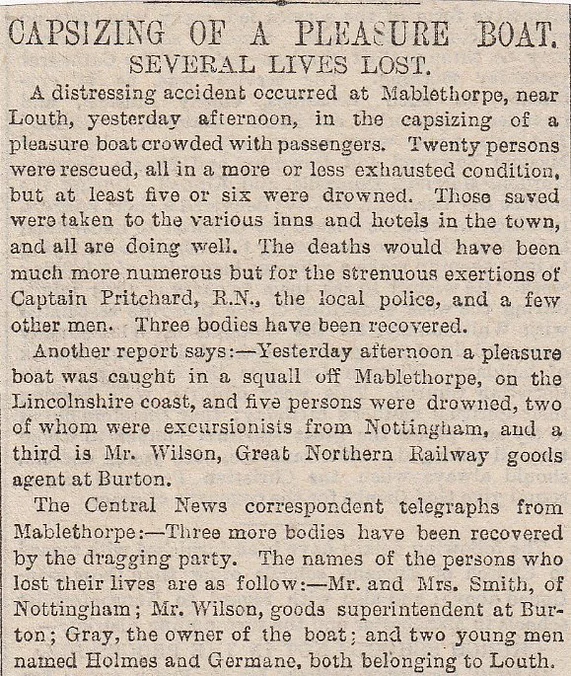
Mablethorpe Boating Accident, May 27th, 1885
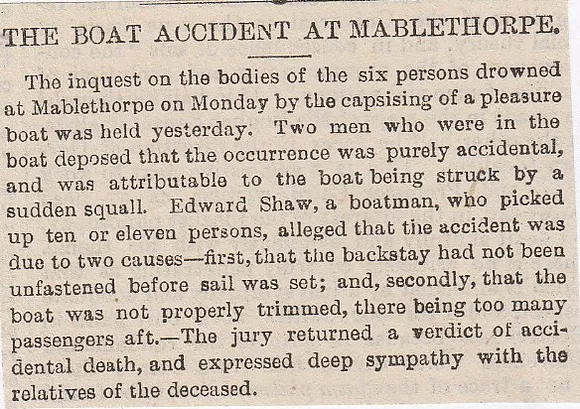
Mablethorpe Boating Accident, June 6th, 1885
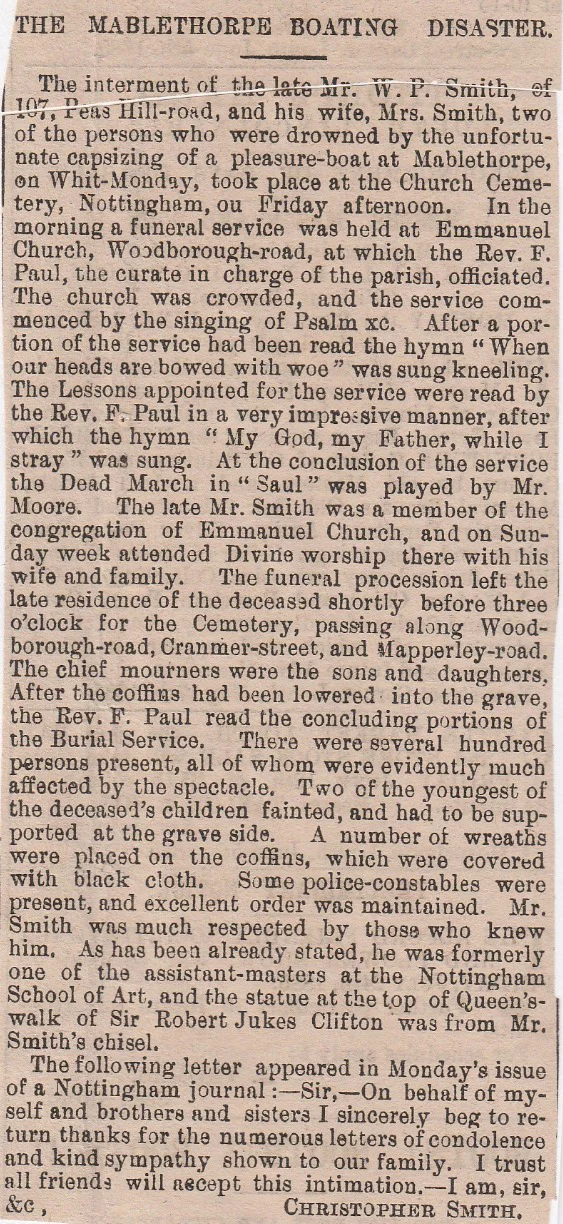
98/ Mablethorpe Bathing Fatality, August 1874
Charlotte Dennis, a seventeen-year-old girl from North Thoresby and under-nursemaid in the family of William Hyde, a Louth solicitor, lost her life while paddling in the sea at Mablethorpe. Dennis went with a fellow servant, Fanny Burton, early Sunday morning. They paddled about for a while then realised then ended up on a sandbank, with water between them and the shore. Neither could swim, but Burton rushed through the water and then turned to see her companion struggling once she had reached the shore. A man named Briggs who was nearby got a life-buoy and plunged in to save Charlotte. He grabbed her hair and she faintly clutched him, then he brought her to the shore. Laid out on the beach it was clear to everybody that Charlotte was extinct. A verdict of “Accidentally Drowned”.
99/ Mablethorpe Drownings, August 1898
A load of excursionists from Nottinghamshire were enjoying a day out in Mablethorpe. John Orton and Ernest Bridgett were hit by a strong wave whilst they were bathing in the unpredictable German Ocean (North Sea) They vanished under the waves but their lifeless corpses were found about fifteen minutes later. They were part of a “Band of Hope” party from Daybrook near Arnold, and both dead men were aged only twenty years.
100/ Mablethorpe Drowning, July 1877

101/ Skegness (Shannon Boat Disaster-30 Dead) July 1893
At 10-30, the London train entered the station at Skegness, with a party of people here for the sea air, and to mess about on the beaches and dunes. This group were from the North London Railway Company and were meeting up at the Pavilion Pleasure gardens at one p.m. At twelve o’clock though, the weather suddenly got worse but not before a boatload of day-trippers had gone for a trip on the “Shannon”. The boat began to waver from side to side as the wind got up and water started to enter the boat, eventually, it capsized with all twenty-eight passengers and the two boatmen precipitated into the water. It was certified to carry sixty passengers, so it wasn’t packed solid or even overcrowded. Of the thirty missing, presumed dead, only twenty bodies were recovered. Two weeks later in Hunstanton, Norfolk, the body of an old man who was on the “Shannon” was washed ashore. All in all four bodies washed up on the Norfolk coast. Eight remained missing.
102/ Skegness Murder, February 11th, 1860
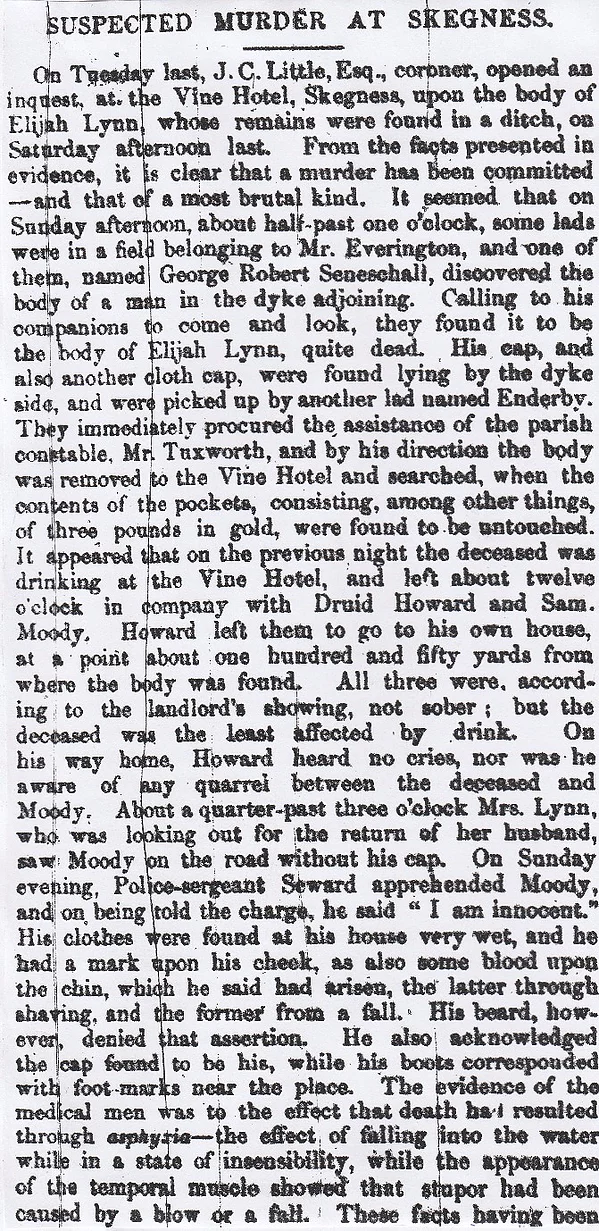
deposed to the Coroner adjourned the inquiry until Tuesday next at 2 o’clock.
Skegness Murder, February 18th, 1860
